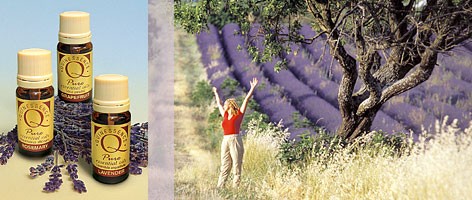
Botany and Aromatherapy
If you are familiar with aromatherapy then you will understand the fundamental role that essential oils play in its practice and success. And because essential oils are derived from various plants, learning about the botany of aromatic plants can be extremely useful if you want to understand more about how essential oils work and what they consist of chemically. So what exactly is botany?
Botany is described as the scientific study of plants, and covers such subjects as their classification, physical appearance, function, chemistry, ecology and even economic importance. Botany seeks to understand how a plant is structured and how it relates to both the environment and its interactions with other plants and organisms.
Although botany is a vast subject, learning just a few of the basics principals will help you in choosing the correct essential oil for a particular condition, and give you a much deeper insight into how essential oils work than can be learned from many aromatherapy books.
Essential oils and plants
The definition of aromatherapy is often described as 'the art and science of using the essential oils derived from plants in a variety of therapeutic applications.' The natural essential oils produced by plants are what give them a recognisable and characteristic aroma, and these healing olis can be found in flowers, leaves, fruits, woods, barks and roots.
Essential oils are located in the tiny glands, hairs, veins or sacs of the various parts of a plant and are extracted by a variety of methods according to the type of plant concerned. Oils from leaves, herbs, roots, woods, barks, spices and some flowers are obtained by traditional steam or water distillation, whereas fruits are cold pressed. Many delicate species of flowers require a more sophisticated process using solvents that produce what is known as an ‘absolute’.
Why plants have essential oils
As plants evolved they developed several strategies to help them survive and compete with the surrounding world. One of these strategies was to produce chemical agents that could both attract pollinators and repel predators, thereby ensuring the continuation of the plant species. Often when an essential oil is located in the root, bark or leaves of a plant it is to defend against predators, whereas the essential oil found in flowers and fruit is produced to attract pollinators.
It is not only the aroma of a plant which draws pollinators to it; color and shape often play a role too. Not all aromas are pleasant, unlike those which we use in the practice of aromatherapy; for example, rotting fruit is attractive to tropical bats just as the seductive scent of night blooming Jasmine (Cestrum noctiflorum) is to hawk moths.
Essential oils evaporate at or above room temperature so, on a hot day, the essential oils contained within a plant are released into the air. In this particular instance, the essential oils are acting as a defense mechanism. The leaves of a plant often contain lethal chemical compounds such as terpenes and any predator that eats the leaves will either become sick or die. Terpenes also restrict the growth of neighboring plants if they enter the soil on watering.
How essential oils are stored in plants
The aromatic molecules in a plant are a by-product of the process of metabolism, and are stored in several parts of the plant, depending upon the species:
Glandular hairs and cells – these are found on the surface of the plant's skin layer in single or multi cell convexities; examples include plants in the Lamiaceae plant family such as Rosemary (Rosmarinus officinalis)
Oil and resin cells – cells filled with resin or oils include those of the Lauraceae plant family such as Cinnamon (Cinnamomum zeylanicum)
Oil or resin canals – when neighboring glandular cells move apart, tubular canals or ducts are formed; these spaces store essential oils of the Apiaceae plant family such as fennel (Foeniculum vulgare) and coriander (Coriandrum sativum)
Oil reservoirs – the formation of secondary cavities from the disintegration of lysigenous secretory cell reservoirs of the Rutaceae plant family such as lemon (Citrus limonum) and bergamot (Citrus bergamia)
This is just a very basic insight into the role in which essential oils play in plants and how it is important - especially as an aromatherapist - to understand the interconnection between botany and aromatherapy. If you are serious about understanding the fascinating complexity of essential oils you should take a more serious look at the vital role that botany plays in aromatherapy.
I promise you it will be time well spent.
Copyright © Quinessence Aromatherapy Ltd 2012. Written by Geoff Lyth
If you enjoyed this article, please click the 'Like' button and help spread the word:
Next Plant Anatomy


